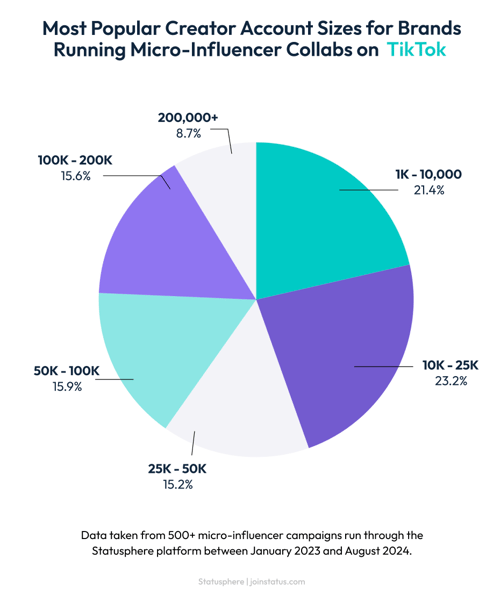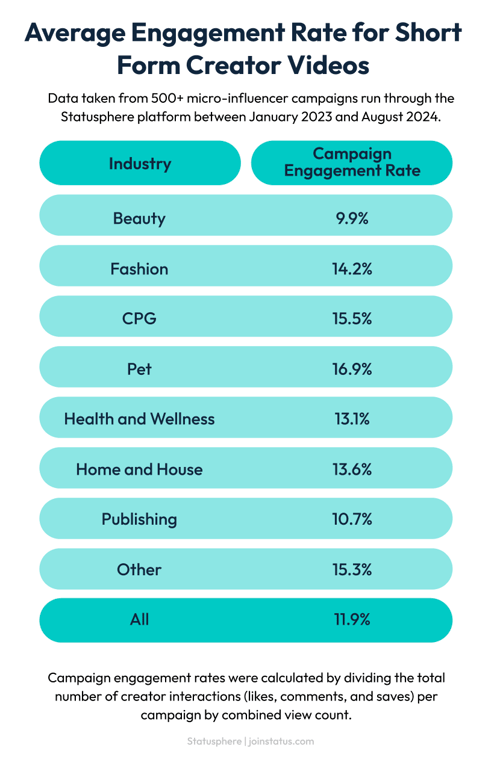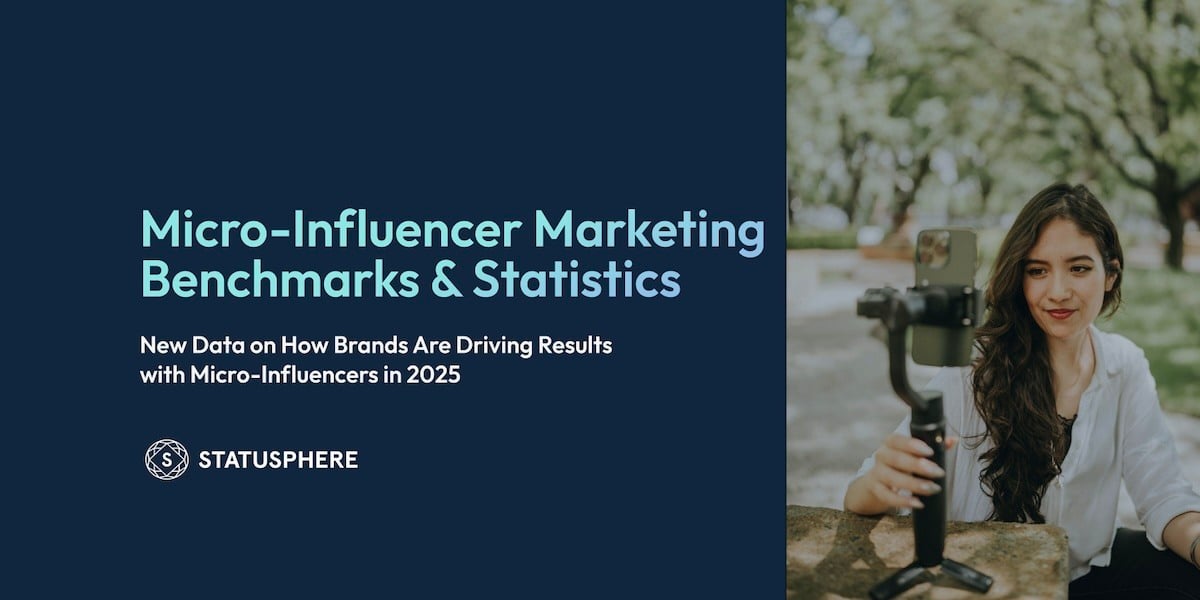.jpeg?width=800&height=439&name=Micro%20Benchmarks%20Cover%20(resized).jpeg)
👉 Get our latest report: The State of Micro-Influencer Marketing in 2025
As we head into 2025, brands continue to move away from polished macro-influencers in favor of everyday creators posting raw, authentic content.
We recently analyzed 34,000+ posts and 900+ campaigns from our micro-influencer marketing platform to highlight why and how brands are making the shift to smaller creator communities.
Below is a snapshot of our full 2025 micro-influencer marketing report, including new data on:
- Top campaign goals for brands
- How brands are repurposing their micro-influencer content
- Video engagement rates for smaller creators
- The biggest industries for micro-influencer collabs
We'll also share recent micro-influencer content trends we've gathered from our platform!
5 Micro-Influencer Statistics and Content Trends for 2025
To kick things off, let's look at some notable stats on the current state of creator campaigns.
These insights can inform your own micro-influencer marketing strategy, including how to stretch more out of your content and maximize your brand's reach.
1. Brands are collaborating with 33% more micro-influencers year-over-year.
Makes sense given that the demand for UGC is so high. From powering paid channels like TikTok Shop or boosting visibility in social search, brands need as much content as they can get.
Smaller creators have historically been favored by both the TikTok and Instagram algorithms. A big part of that is due to their authentic content driving authentic engagement.
2. 66% of brands plan to repurpose their micro-influencer content in TikTok Spark Ads this year.
Repurposing influencer content via TikTok Spark Ads and Instagram Partnership Ads has become the fastest-growing goal of brands doing micro-influencer collabs.
The fact that it's easier than ever for brands to get creator ad codes is a nice added bonus given how much influencers boost paid campaign performance. We expect this trend to continue through 2025, especially as TikTok and Instagram experiment with new influencer ad formats.
3. 87% of micro-influencer content requested last year was short-form video (TikToks & Instagram Reels).
The boom of short-form video isn't a big surprise, but its growth as an influencer content format has really spiked over the past year. We've also seen a massive drop (74% year-over-year) in static In-Feed Instagram posts requested by brands in favor of Reels.
4. Top-performing micro-influencer videos on TikTok and Instagram Reels are between 20 and 40 seconds long.
Beyond our benchmark report, we recently conducted an analysis of 2,000 creator videos to determine the best lengths for TikToks and Reels. We found that keeping videos on the shorter side (less than 30 seconds) is a safe bet across both platforms for optimal engagement.
Of course, creators know best when it comes to content trends and video lengths. For example, some types of beauty products do better in longer-form content such as how-tos or tutorials.
5. Micro-influencer videos with voice-overs get more views on TikTok (8%) and Reels (10%) than videos without them.
This is another stat that aligns with both the rise of influencer reviews and UGC ads. If you look at paid creator posts on TikTok and Instagram, chances are you'll see your fair share of reviews featuring voice-overs. Social search plays a big role in this trend as platforms can pick up spoken social media keywords and boost their rankings to relevant searchers.
What Are the Top Goals of Micro-Influencer Marketing Campaigns?
Increasing brand awareness is the #1 campaign goal for micro-influencer collabs and remains the top goal for brands throughout 2024. In fact, it's been the top goal for three years straight.
 Smaller influencers are valuable throughout the funnel, especially at the top for the sake of awareness. However, consider how brands are also making influencer content into ads to drive conversions at the bottom.
Smaller influencers are valuable throughout the funnel, especially at the top for the sake of awareness. However, consider how brands are also making influencer content into ads to drive conversions at the bottom.
The fact that repurposing content in ads has grown as a campaign goal by 80% within the past year highlights just how much brands are scaling UGC ads. This likewise illustrates how micro-influencers can help brands hit multiple marketing goals at once.
Micro-Influencer Follower Count & Engagement Rate Benchmarks
Defining “good” engagement or a definitive follower count for micro-influencers is complicated.
Because you'll get totally different answers depending on who you ask.
That said, we put together the following influencer marketing benchmarks based on hundreds of campaigns and thousands of creator posts. Our goal is to illustrate the distribution of influencer follower counts and engagement rates across industries and campaigns.
Micro-Influencer Follower Counts
Making the distinction between micro-influencers and nano or power-middle influencers can feel like splitting hairs. Especially since different industries have different expectations and brands often work with creators of various sizes at the same time.
We typically say that creators with ~10,000 and ~100,000 followers fall within the “micro” category. Looking at recent collaborations in our platform, here's the distribution of influencer follower counts from brands primarily partnering with micro-influencers on TikTok:

TikTok Influencers with 10,000 to 25,000 followers are the most popular type of creators for brand collabs. The median follower count for TikTok influencers across all industries was 31,700 followers for the campaigns we examined. In total, TikTok influencers partnering with brands had an average of 78,525 followers.
Now, let's look at a similar follower count breakdown for micro-influencer collabs on Instagram:

Instagram influencers with <10,000 followers are the most popular types of creators for brand collabs. Of the campaigns examined, the median follower count for Instagram influencers across all industries was 12,479 followers. Instagram micro-influencers partnering with brands had an average of 32,367 followers.
Our take? Brands shouldn't obsess over follower counts but instead focus on the potential reach and engagement that smaller creators can generate. Like with any other type of marketing campaign, brands should experiment and diversify their strategies to see what works best.
Micro-Influencer Engagement Rates
Engagement rate is often seen as the measuring stick for brands working with influencers.
That said, there's a big distinction between a creator's account engagement rate and content engagement rate. Especially with short-form videos that measure loops, shares, comments and interactions against views (not followers). This distinction isn't always made clear in reports.
Below is an analysis of average influencer engagement rates for short-form video campaigns on TikTok and Instagram within our platform.

Note that engagement rates from this analysis come from vetted creators matched with brands using the Statusphere platform's 250+ targeting data points. As a result, these numbers trend higher than average engagement rates from non-vetted creators reported in third-party data.
Want More Micro-Influencer Marketing Benchmarks? Grab Our Full Report!
Smaller creators, big results.
That's the short version of why brands are hiring more micro-influencers than ever before.
There's power in numbers. Brands rely on micro-influencers to maintain visibility in algorithms and reach their target audiences. Trends like social search, UGC ads and channels like TikTok Shop have made scaling influencer content a top priority.
Want more insights into how brands are driving results with smaller creators? Check out our full micro-influencer benchmark report to dig deeper into industry insights and success stories to inspire your own influencer marketing strategy in 2025 and beyond.
